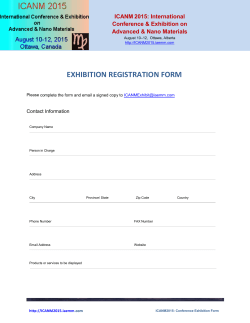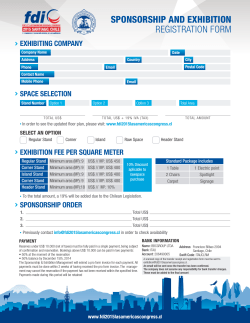
Mid-IR Detection of Circulating Tumor Cells
About Omics Group OMICS Group International through its Open Access Initiative is committed to make genuine and reliable contributions to the scientific community. OMICS Group hosts over 400 leading-edge peer reviewed Open Access Journals and organize over 300 International Conferences annually all over the world. OMICS Publishing Group journals have over 3 million readers and the fame and success of the same can be attributed to the strong editorial board which contains over 30000 eminent personalities that ensure a rapid, quality and quick review process. About Omics Group conferences • OMICS Group signed an agreement with more than 1000 International Societies to make healthcare information Open Access. OMICS Group Conferences make the perfect platform for global networking as it brings together renowned speakers and scientists across the globe to a most exciting and memorable scientific event filled with much enlightening interactive sessions, world class exhibitions and poster presentations • Omics group has organised 500 conferences, workshops and national symposium across the major cities including SanFrancisco,Omaha,Orlado,Rayleigh,SantaClara,Chicago,P hiladelphia,Unitedkingdom,Baltimore,SanAntanio,Dubai,H yderabad,Bangaluru and Mumbai. Quantum Cascade Lasers in BioMedical Applications The Reality Check Igor Trofimov PTAC Inc. 2nd International Conference and Exhibition on Lasers, Optics & Photonics September 8, 2014 Why Would One Care of Mid-IR? Fundamental vibrations of all molecules reside in Mid-IR – strongest interaction with light. Fingerprint region • • • Sensing (gases , liquids, solids) cells & bacteria Imaging (tissue) without contrast agents, dyes or stains Photo-chemistry, welding, cutting and ablation Diagnosis Screening Pharma C T C Prognosis Therapy response Research 2nd International Conference and Exhibition on Lasers, Optics & Photonics September 8, 2014 Mid-IR Sources Fourier Transform Spectrometer • Low power • Low brightness • Low spatial resolution • Bulky End of Lead Salt Laser Production 04.01.12 Product Discontinuation US27-075 Lead salt lasers have been widely used for high resolution IR spectroscopy since the 1970’s. Laser Components has been actively supporting the research community and has been a major supplier of these tunable diode lasers. Many researchers have recently focused on newer Quantum Cascade technology and the demand for lead salt lasers has been steadily declining. Due to lack of demand, LASER COMPONENTS will discontinue production of lead salt lasers 2nd International Conference and Exhibition on Lasers, Optics & Photonics September 8, 2014 Mid-IR Sources OPA &DFG The 800mn light is converted to MidInfrared radiation, ranging from 4 to 20 µm. Prof. Andrea Cavalleri, Max Planck Institute for the Structure and Dynamics of Matter Free Electron Laser Free-electron lasers involve major facilities. Broadband tunable 2-12 µm macro-pulse length > 10 µs ▪ ≈ 100 mJ / macro-pulse ▪ 10 – 20 µJ / micro-pulse Synchrotron beam Mid-IR microscopy 2nd International Conference and Exhibition on Lasers, Optics & Photonics September 8, 2014 Mid-IR Sources - QCL Power >5W Wavelength 3-24µm DFB, External Cavity, Multi-emitter Fiber coupled 2nd International Conference and Exhibition on Lasers, Optics & Photonics September 8, 2014 QCL Technology is There! Where are the Applications? 2nd International Conference and Exhibition on Lasers, Optics & Photonics September 8, 2014 Breath Analysis • Relatively inexpensive • Rapid • Non-invasive Landmark in clinical breath testing occurred in 2003 when the FDA approved the first device that measures the fraction of exhaled nitric oxide (FENO) for asthma monitoring. Current clinical use of breath analysis: • • • • • monitor asthma diagnose transplant organ rejection diagnose Helicobacter pylori infection detect blood alcohol concentration monitor breath gases during anesthesia, mechanical ventilation, and respiration 2nd International Conference and Exhibition on Lasers, Optics & Photonics September 8, 2014 Breath Analysis 2nd International Conference and Exhibition on Lasers, Optics & Photonics September 8, 2014 Breath Analysis NONE REQUIRES QCL! 2nd International Conference and Exhibition on Lasers, Optics & Photonics September 8, 2014 Breath Analysis Toshiba Develops Breath Analyzer for Medical Applications 18 March, 2014 TOKYO – Toshiba Corporation announced that it has developed a prototype of a compact breath analyzer that can detect a wide range of trace gases in exhaled breath. The analyzer has the potential to provide analysis that can be applied to health monitoring and diagnosis of disease. Constituents that can be measured by a breath analyzer Acetaldehyde: Intermediate of alcohol metabolism. The cause of hangovers. Acetone: Intermediate of fatty acid metabolism. An indicator of obesity and diabetes. Carbon monoxide: Intermediate of heme catabolism. An indicator of smoking Constituents that will be measured by a breath analyzer in the future Methane: Discharge from metabolism of intestinal bacterium. An indicator of the intestinal environment. Nitric monoxide: Generated by airway inflammation. An indicator of asthma. 13C carbon dioxide: Generated by 13C-labeled drug metabolism. Used for helicobacter pylori testing. 2nd International Conference and Exhibition on Lasers, Optics & Photonics September 8, 2014 Breath Analysis "Breath analysis as a tool for early disease detection" a project by iMERA (implementing Metrology in the European Research Area), an initiative of the European Metrology Research Programme (EMRP). Cystic fibrosis - the most common lethal genetic disease in the Caucasian population affecting more than 70,000 individuals worldwide. Most patients are infected by the bacteria Pseudomonas aeruginosa. Early treatment of the infection leads to a pronounced survival benefit. Stefan T. Persijn and Adriaan M.H. van der Veen 2013 Smoking kills! 2nd International Conference and OSAExhibition Precision Monitoring on Lasers, Optics of Hman & Photonics Metabolism Workshop September 8, 2014 February 17, 2014 Prospects of QCLs for Breath Analysis Diagnostics - Rare cases, mostly complimentary Disease progression monitoring - likely Treatment efficacy -likely Economics factors 2nd International Conference and OSAExhibition Precision Monitoring on Lasers, Optics of Hman & Photonics Metabolism Workshop September 8, 2014 February 17, 2014 Blood Glucose Monitoring 3 million people in US with Type1 diabetes 100,000 users of CGM will grow to 450,000 $1.8 Billion market opportunity M.Pleitez 2012 B.Lendl 2010 Set of 42 different patients Glucose in blood serum prediction error 6.9 mg/dl Triglycerides cross-validation error of 17.5 mg/dl In spiked serum samples the lactate concentration could be determined with cross-validation error of 8.9 mg/dl. B.Lendl 2010 2nd International Conference and Exhibition on Lasers, Optics & Photonics September 8, 2014 Blood Glucose Diffuse reflectance Gmachl 2014 Photo-acoustics Mid-IR penetration depth <45 mm S/N=1 at 100mg/dL M.Sigrist 2012 2nd International Conference and Exhibition on Lasers, Optics & Photonics September 8, 2014 Cell Differentiation • Circulating tumor cells • Leukemia • Malaria • CTCs originate from solid tumor, circulate in blood stream, and may seed metastasis Estimated frequency of one in 100 million to one in a billion blood cells • Flow cytometry - 2 cells/mL • Screening >100 cells/ml 0.14 0.12 White blood cells MR1 cells 0.10 Absorbance • 0.08 0.06 0.04 0.02 0.00 900 1000 1100 1200 1300 1400 1500 1600 Wavenumber, 1/cm Leukocytes and MR1 in PBS (106/mL) 2nd International Conference and Exhibition on Lasers, Optics & Photonics September 8, 2014 Mid-IR Imaging • Chemical imaging – digital histopathology • Over 90% of cancers start in epithelial tissues • Cell dynamics – live cells B. Guo, Y. Wang, C. Peng, H. Zhang, G. Luo, H. Le, C. Gmachl, D. Sivco, M. Peabody and A. Cho, Optics Express, 2004, 12, 208 2nd International Conference and Exhibition on Lasers, Optics & Photonics September 8, 2014 Mid-IR Imaging Spectral range 900-1800cm-1 Power >10mW Diffraction limited spatial resolution P.Bassan 2014 2nd International Conference and Exhibition on Lasers, Optics & Photonics September 8, 2014 Mid-IR Laser Surgery Mid-IR spectral range is attractive for highly precise surgical procedures and medical ablation of both soft and hard tissue because of the following main reasons: • it has absorption-dominant properties and its high absorption by water and proteins is associated with minimal penetration depth within tissue • mid-IR tissue ablation effects are superficial with submicron ablation rates and with minimal submicron damage layers around the exposed area • mid-IR radiation lacks the carcinogenetic potential that has generated concern at ultraviolet laser tissue interaction 2nd International Conference and Exhibition on Lasers, Optics & Photonics September 8, 2014 Mid-IR Laser Angioplasty Atherosclerotic plaques consist mainly of cholesterol esters. Radiation at a wavelength of 5.75 μm is strongly absorbed by the C=O stretching vibration mode of cholesterol esters. QCL 500ns 1MHz 200W/cm2 DFG 5ns 10Hz 50W/cm2 K. Awazu 2008, 2012 Higher peak power is needed 2nd International Conference and Exhibition on Lasers, Optics & Photonics September 8, 2014 Laser ablation of corneal stroma Absorption bands of the amide protein groups Amide-I and Amide-II 6.1 μm and 6.45 μm QCL a) 20ms 25Hz Depth 50 μm b) 10ms 25Hz Depth 20 μm c) 5ms 100Hz Depth 6 μm d) 5ms 10Hz Less collateral damage than at 3 μm Not as good as Excimer laser Jin U. Kang 2012 Higher peak power is needed 2nd International Conference and Exhibition on Lasers, Optics & Photonics September 8, 2014 Thank You Katya Zhupan, U. Michigan Ann Arbor Sergey Agoulnik, Eisai Pharmaceutical Ian Lewis, Princeton University Michel Nofal, Princeton University Loan Le, Princeton University Sabbir Liakat, Princeton University Claire Gmachl, Princeton University NSF ERC MIRTHE, NSF 2nd International Conference and Exhibition on Lasers, Optics & Photonics September 8, 2014 Many biological experiments are performed under the assumption that all cells of a particular “type” are identical. However, recent data suggest that individual cells within a single population may differ quite significantly and these differences can drive the health and function of the entire cell population. Single cell analysis comprises a broad field that covers advanced optical, electrochemical, mass spectrometry instrumentation, and sensor technology, as well as separation and sequencing techniques. Although the approaches currently in use can offer snapshots of single cells, the methods are often not amenable to longitudinal studies that monitor changes in individual cells in situ. The NIH Single Cell Analysis Program (SCAP) is searching for novel methods for analyzing dynamic states of individual cells that can serve as the basis for predicting alterations in cell behavior and function over time. The ultimate goal is to develop new tools and methods that allow time-dependent measurements at the single cell level in a complex tissue environment to assess functional changes, provide information on the health status of a given cell, and help guide diagnosis and therapeutic treatments related to human disease states. Technological breakthroughs in this arena could allow researchers and physicians to identify rare cells in a mixed population such as individual cells that can transform and become cancerous; cells that are latently infected with a pathogenic virus; or cells that develop resistance to drugs over time. This challenge is structured in 2 phases: Phase 1 is a Theoretical Challenge and Phase 2, a Reduction to Practice Challenge. Phase 1 may award up to 6 prizes from a total prize award pool of $100,000 for the theoretical portion of the competition. 2nd International Conference and Exhibition on Lasers, Optics & Photonics September 8, 2014 Let Us Meet Again We welcome all to our future group conferences of Omics group international Please visit: www.omicsgroup.com www.Conferenceseries.com http://optics.conferenceseries.com/
© Copyright 2025












